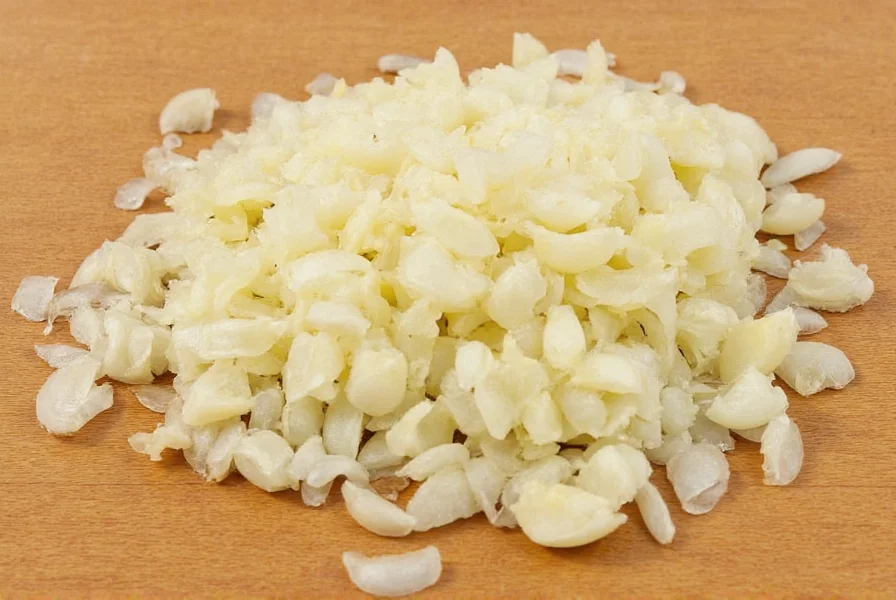Understanding garlic measurements is crucial for consistent cooking results. Whether you're following a family recipe or experimenting with new cuisines, knowing the precise conversion between fresh garlic cloves and minced garlic prevents flavor imbalances that can ruin your dish. Many home cooks face confusion when recipes specify “one clove” while they only have pre-minced garlic available – or vice versa – leading to dishes that are either bland or overwhelmingly garlicky.
Garlic Measurement Fundamentals
Garlic comes in various forms, each with distinct flavor profiles and measurement requirements. Fresh garlic cloves contain natural enzymes that create more complex flavors when crushed or minced, while jarred minced garlic often includes preservatives that slightly alter the taste. Understanding these differences helps you make informed substitutions without compromising your dish.
Precise Conversion Guide
Accurate garlic measurement depends on both the form and size of the garlic:
| Garlic Form | Equivalent to 1 Medium Clove | Notes |
|---|---|---|
| Fresh garlic, minced | ½ teaspoon | Finely minced by hand |
| Jarred minced garlic | ½ teaspoon | May contain citric acid or oil |
| Garlic paste | ¼ teaspoon | More concentrated flavor |
| Garlic powder | ⅛ teaspoon | Use 1/8 tsp powder = 1 clove |
These measurements apply to medium-sized garlic cloves (about 1 inch long and ¼ inch in diameter). Larger cloves may yield up to 1 teaspoon of minced garlic, while smaller cloves might only produce ⅛ teaspoon.
Flavor Differences Between Fresh and Minced Garlic
Fresh garlic offers a brighter, more complex flavor profile compared to jarred alternatives. When you crush or mince fresh garlic, enzymes create allicin – the compound responsible for garlic's characteristic aroma and health benefits. This reaction doesn't occur in pre-minced garlic, which has already undergone this chemical process before bottling.
Jarred minced garlic often contains citric acid or oil as preservatives, which slightly mellows the flavor. While convenient, it generally lacks the depth of freshly minced garlic. For most recipes, you can substitute them using the conversion ratios above, but adjust based on your taste preferences and the dish's requirements.
Practical Substitution Tips
When substituting between fresh and minced garlic, consider these professional cooking tips:
- For delicate dishes like fish or light sauces, use slightly less jarred garlic (⅜ of the recommended amount) as its flavor is more consistent
- In long-cooked dishes like stews or braises, fresh garlic holds up better than jarred versions
- When using jarred minced garlic in raw applications (like salad dressings), let it sit for 10 minutes after mixing to develop more flavor
- Freeze excess fresh minced garlic in ice cube trays with olive oil for future use – this maintains flavor better than commercial jarred products
Storage Considerations
Proper storage affects both measurement accuracy and flavor intensity. Fresh garlic stored at room temperature maintains its potency for weeks, while jarred minced garlic gradually loses flavor over time. Always check the “use by” date on commercial products, as older minced garlic may require slightly larger quantities to achieve the same flavor impact.
For best results, store fresh garlic in a cool, dark place with good air circulation. Avoid refrigeration, which can cause sprouting and texture changes. If you've minced fresh garlic yourself, store it in an airtight container in the refrigerator for up to one week, or freeze it for longer storage.
When Precision Matters Most
Certain recipes demand exact garlic measurements. In aioli, mayonnaise-based sauces, and vinaigrettes, too much garlic can overpower delicate flavors. Conversely, in garlic-heavy dishes like aglio e olio or garlic bread, precise measurements ensure the garlic flavor shines without becoming harsh or bitter.
Professional chefs often recommend starting with slightly less garlic than a recipe specifies, then adjusting to taste after cooking. This approach works particularly well when substituting between fresh and pre-minced forms, as individual garlic potency can vary based on growing conditions and freshness.
Frequently Asked Questions
How much jarred minced garlic equals three fresh cloves?
Three medium fresh garlic cloves equal approximately 1½ teaspoons of jarred minced garlic. For larger cloves, you might need up to 2 teaspoons. Always adjust based on your taste preferences and the specific dish you're preparing.
Can I substitute garlic powder for fresh minced garlic?
Yes, but use less – 1/8 teaspoon garlic powder equals one fresh garlic clove. Garlic powder has a more concentrated flavor and lacks the moisture of fresh garlic, so you may need to adjust liquid ingredients slightly when making this substitution in recipes.
Why does my jarred minced garlic taste different from fresh?
Jarred minced garlic contains preservatives like citric acid and sometimes oil, which alter its flavor profile. The enzymatic reaction that creates fresh garlic's complex flavors happens immediately after mincing, so pre-minced garlic has a more consistent but less nuanced taste compared to freshly prepared garlic.
How do I convert recipes that call for “garlic, minced” to use whole cloves?
For recipes specifying “minced garlic,” use one medium garlic clove for every ½ teaspoon of minced garlic called for. If the recipe specifies “3 cloves, minced,” you'll need three whole cloves that you mince yourself to achieve the proper flavor balance.
Does the size of garlic cloves really matter in recipes?
Yes, significantly. Garlic cloves can vary from small (¼ inch diameter) to jumbo (over ½ inch). Small cloves yield about ⅛ teaspoon minced, while large cloves can produce up to 1 teaspoon. For critical recipes, weighing cloves (1 medium clove = 5-7 grams) provides the most accurate measurement.











 浙公网安备
33010002000092号
浙公网安备
33010002000092号 浙B2-20120091-4
浙B2-20120091-4